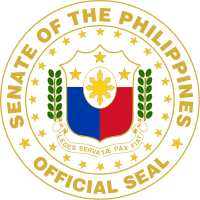Senate of the Philippines
The Senate of the Philippines ( Tagalog : Senado ng Pilipinas ) is, along with the House of Representatives, one of the two chambers of the Philippine Congress .
The Senate is composed of 24 nationally elected senators who do not represent a specific constituency . The senators are elected for a six-year legislative period , with 12 senate seats to be elected every three years.
The business of the Senate is directed by the Senate President , who is represented by the Senate President pro tempore in his absence . Senate policy is essentially shaped by the majority leader and the minority leader .
In addition, the Senate comprises 37 specialist committees and a further 33 ad hoc and supervisory committees, so that each Senator usually chairs one of these bodies several times.
With 24 senators, the Philippine Senate is one of the smallest upper house chambers in the world in terms of population size.
history
Between 1907 and 1916, the Philippine Commission served as the first chamber of legislature, chaired by the United States Governor General of the Philippines . This organ then also had the executive power .
On August 29, 1916, the Philippine Autonomy Act ( Jones Law ) resolved to establish a congress, which was composed of the Senate and a second chamber, the House of Representatives, and was called the Philippine Legislature . With the establishment of the Commonwealth of the Philippines in 1935, the bicameral system was abolished and a national assembly was introduced, as provided for by the Tydings – McDuffie Act . In 1940 an agreement was reached on the reintroduction of the two-chamber system, the Commonwealth Congress , with a view to the time after a future sovereignty of the Philippines. The elections for this took place in November 1941, but he could no longer take up his activity due to the invasion of Japan . The Senate of the Commonwealth Congress only met in full for the first time after the elections in June 1945.
After the imposition of martial law by President Ferdinand Marcos in 1972, the Congress of the House and Senate was disbanded. It was not until 1987, after President Marcos lost power in the wake of the people power revolution through the constitution of the Philippines, that the Senate was reinstated.
Current Senate Members
The following list represents the current composition of the Senate. In the left row are the senators whose election period expires on June 30, 2019 and in the right row the senators whose election period ends on June 30, 2022. The beginning of the current term of office as senator is shown in brackets.
|
|
List of Senate Presidents
|
|
Office of the Secretary of the Senate
The secretariat of the Senate is headed by a secretary elected by the members of the Senate. The Secretary assists the Senate President with adequate and timely legislation as well as with administrative support for the Senators' offices. He exercises the overall supervision and control over all offices of the service units and all officials and employees of the secretariat. He formulates plans, strategies and programs to professionalise the facility.
The secretary is assisted by appointed vice secretaries and the sergeant-at-arms , who is also elected by the senators. The Secretariat is divided into four main departments in the Senate Secretary's Office: Legislative Department, Department of Administration and Finance, Office of Foreign Affairs and Relations, and the Office of the Sergeant-at-Arms.
Web links
Individual evidence
- ↑ The American Era ( Memento of October 16, 2007 in the Internet Archive ) (English)



